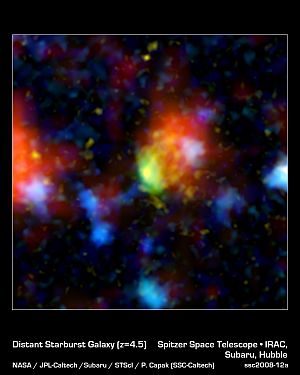Baby boom galaxy facts for kids

The Baby boom galaxy is a special type of galaxy called a starburst galaxy. This means it is making stars at an incredibly fast rate. It is located about 12.2 billion light-years away from us. This means we are seeing it as it was 12.2 billion years ago!
Scientists at NASA's Spitzer Science Center discovered this amazing galaxy. It holds the record for being the brightest starburst galaxy ever found in the very distant universe. Its extreme brightness comes from how quickly it is forming new stars.
The Baby boom galaxy has been called "the extreme stellar machine." It creates up to 4,000 new stars every single year! To compare, our own Milky Way galaxy only makes about 10 new stars each year.
At this incredible speed, the Baby boom galaxy could grow to be as big as the most massive galaxy known in just 50 million years. That's super fast for a galaxy!
This discovery is very important because it challenges how scientists thought galaxies usually grow. Most galaxies were thought to grow slowly by crashing into and absorbing smaller pieces of other galaxies. But the Baby boom galaxy seems to be growing very quickly from the inside out. Another surprising thing is that scientists are seeing this galaxy when the universe was only about 1.4 billion years old. This means the galaxy was already making stars at a crazy rate when the universe was still very young.
Peter Capak from NASA's Spitzer Science Center said, "This galaxy is undergoing a major baby boom, producing most of its stars all at once." Nick Scoville from Caltech, who leads the Cosmic Evolution Survey, added, "We may be seeing, for the first time, how one of the most massive galaxies in the universe formed."
Seeing the Galaxy in Different Ways
When we look at the Baby boom galaxy, different colors in its image tell us different things. This is because scientists use special telescopes that can see different types of light, or "wavelengths." These different wavelengths show us various parts of the galaxy and what they are doing. For example, warm dust heated by new stars gives off certain colors of light.
Here's what some of the colors in the image can tell us:
| The Color | What the Color Shows |
|---|---|
| Green | Shows where gas is in the Baby boom galaxy. |
| Blue | Shows parts of the galaxy that are not making many stars. |
| Yellow/orange | Shows light from stars in the outer parts of the galaxy. |
| Red | Shows where brand new stars are being born. |

